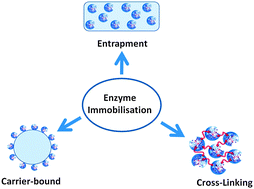Great attention is focused on the burgeoning role of biocatalysis in industrial processes. Enzymes offer a mild, efficient and “green” process that can save money, conserve energy and cut down on waste compared to conventional chemistry. However, despite their advantages, the implementation of enzymatic processes in industry suffers from a number of limitations. Enzymes are often unstable to the industrial or storage conditions, and can be difficult to recover and re-use.
Enzyme immobilisation is one way to combat these drawbacks. In addition to facilitating the storage, recovery and re-use of an enzyme, immobilisation also affords the more convenient handling of the enzyme as well as reducing its toxicity in cases. As part of Chem Soc Rev‘s upcoming ‘Enzyme Immobilisation’ themed issue, Professor Roger A. Sheldon and Dr. Sander van Pelt of Delft University of Technology have produced a Tutorial Review shedding light on the role of this key application in biocatalysis.
The Tutorial Review – which is accompanied by additional PDF slides in the electronic supplementary information (ESI) – highlights a number of key learning points, including the advantages and limitations of the various approaches to enzyme immobilisation. The types of immobilisation are discussed in detail, from binding to a carrier, to entrapment and cross-linking, including cross-linked enzyme aggregates (CLEAs). Helpfully, Sheldon and von Pelt also clarify immobilisation terminology, which is often confusing and inconsistent.
Given the potential of this technology, especially in the chemical industry, it is essential that we gain more insight into the performance and application of immobilised enzymes. This Tutorial Review is a step towards that objective and offers an enlightening overview of this fascinating subject.
For more, read this Chemical Society Reviews article today:
Enzyme immobilisation in biocatalysis: why, what and how
Roger A. Sheldon and Sander van Pelt
Chem. Soc. Rev., 2013, Advance Article
DOI:10.1039/C3CS60075K
Ruth Gilligan is a guest web-writer for Chem Soc Rev. She has recently completed her PhD in the group of Prof. Matthew J. Gaunt at the University of Cambridge, focusing on the development and application of C–H functionalisation methodology.











